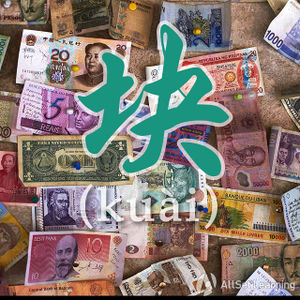Difference between revisions of "Counting money"
| Line 33: | Line 33: | ||
<div class="liju"> | <div class="liju"> | ||
| − | * 三 <em>块</em> 八<span class="trans">Three kuai eight (3.8)</span> | + | * 三 <em>块</em> 八<span class="pinyin">sān <em>kuài</em> bā </span><span class="trans">Three kuai eight (3.8)</span> |
| − | * 十 <em>块</em> 二<span class="trans">Ten kuai two (10.2)</span> | + | * 十 <em>块</em> 二<span class="pinyin">shí <em>kuài</em> èr</span><span class="trans">Ten kuai two (10.2)</span> |
| − | * 九 <em>块</em> 五<span class="trans">Nine kuai five (9.5)</span> | + | * 九 <em>块</em> 五<span class="pinyin">jiǔ <em>kuài</em> wǔ</span><span class="trans">Nine kuai five (9.5)</span> |
| − | * 一 <em>块</em> 七<span class="trans">One kuai seven (1.7)</span> | + | * 一 <em>块</em> 七<span class="pinyin">yī <em>kuài</em> qī</span><span class="trans">One kuai seven (1.7)</span> |
| − | * 五 十 <em>块</em> 五<span class="trans">Fifty kuai five (50.5)</span> | + | * 五 十 <em>块</em> 五<span class="pinyin">wǔ shí <em>kuài</em> wǔ</span><span class="trans">Fifty kuai five (50.5)</span> |
| − | * 七 十 二 <em>块</em> 四<span class="trans">Seventy-two kuai four (72.4)</span> | + | * 七 十 二 <em>块</em> 四<span class="pinyin">qīshí'èr <em>kuài</em> sì</span><span class="trans">Seventy-two kuai four (72.4)</span> |
| − | * 二 十 三 <em>块</em> 八<span class="trans">Twenty-three kuai eight (23.8)</span> | + | * 二 十 三 <em>块</em> 八<span class="pinyin">èr shí sān <em>kuài</em> bā</span><span class="trans">Twenty-three kuai eight (23.8)</span> |
| − | * 两 百 一 十 二 <em>块</em> 三<span class="trans">Two hundred and twelve kuai three (212.3)</span> | + | * 两 百 一 十 二 <em>块</em> 三<span class="pinyin">liǎng bǎi yīshí'èr <em>kuài</em> sān</span><span class="trans">Two hundred and twelve kuai three (212.3)</span> |
| − | * 一 百 七 十 二 <em>块</em> 四<span class="trans">One hundred and seventy-two kuai four (172.4)</span> | + | * 一 百 七 十 二 <em>块</em> 四<span class="pinyin">yī bǎi qī shí èr <em>kuài</em> sì</span><span class="trans">One hundred and seventy-two kuai four (172.4)</span> |
| − | * 一 千 三 百 五 十 八 <em>块</em> 五<span class="trans">One thousand three hundred and fifty-eight kuai five (1358.5)</span> | + | * 一 千 三 百 五 十 八 <em>块</em> 五<span class="pinyin">yī qiān sānbǎi wǔshíbā <em>kuài</em> wǔ</span><span class="trans">One thousand three hundred and fifty-eight kuai five (1358.5)</span> |
</div> | </div> | ||
| Line 51: | Line 51: | ||
<div class="liju"> | <div class="liju"> | ||
| − | * 三 <em>块</em> 八 毛 六<span class="expl">3.86</span><span class="trans"></span> | + | * 三 <em>块</em> 八 毛 六<span class="expl">3.86</span><span class="pinyin">sān <em>kuài</em> bā máo liù</span><span class="trans"></span> |
</div> | </div> | ||
| Line 62: | Line 62: | ||
<div class="liju"> | <div class="liju"> | ||
| − | * 三 <em>块</em><span class="trans">Three kuai</span> | + | * 三 <em>块</em><span class="pinyin">sān <em>kuài</em> </span> <span class="trans">Three kuai</span> |
</div> | </div> | ||
Revision as of 08:44, 30 October 2014
-
Level
-
Similar to
-
Used for
-
Keywords
Cash rules everything around us, and in China there's no exception. Mastering how to say quantities of money is vital!
Structure
Chinese has a specific structure for talking about quantities for money:
Number + 块 + Number + 毛
Examples
- 三 块 八 毛 3.8
- 十 块 两 毛 10.2
- 九 块 五 毛 9.5
- 一 块 七 毛 1.7
- 五 十 块 五 毛 50.5
- 七 十 二 块 四 毛 72.4
- 一 百 块 五 毛 100.5
- 五 百 块 三 毛 500.3
- 两 千 两 百 块 两 毛 2200.2
- 三 千 一 百 块 一 毛 3100.1
If the smaller units are only in tens, you can just say the number of tens. So 3.86 RMB is "三 块 八 (sān kuài bā)". Also this way of speaking is normally only used in matters with less than 100.
- 三 块 八Three kuai eight (3.8)
- 十 块 二Ten kuai two (10.2)
- 九 块 五Nine kuai five (9.5)
- 一 块 七One kuai seven (1.7)
- 五 十 块 五Fifty kuai five (50.5)
- 七 十 二 块 四Seventy-two kuai four (72.4)
- 二 十 三 块 八Twenty-three kuai eight (23.8)
- 两 百 一 十 二 块 三Two hundred and twelve kuai three (212.3)
- 一 百 七 十 二 块 四One hundred and seventy-two kuai four (172.4)
- 一 千 三 百 五 十 八 块 五One thousand three hundred and fifty-eight kuai five (1358.5)
The first number is the amount of whole RMB (or dollars etc.), and the second is the amount smaller units (e.g. cents). So 3.86 RMB is
- 三 块 八 毛 六3.86
And if there's no smaller unit, e.g. 3 RMB, you can just say:
- 三 块 Three kuai
块 (kuài) is the more common, informal way to talk about money. More formally you can use 元 (yuán) in exactly the same way. This is similar to the difference between "dollars" and "bucks" in American English, or "pounds" and "quid" in British English. 块 (kuài) is appropriate in more situations than "bucks" or "quid", though.
See also
Sources and further reading
Books
- A Practical Chinese Grammar For Foreigners (外国人实用汉语语法) (pp. 88-9) →buy
- Integrated Chinese: Level 1, Part 1 (3rd ed) (pp. 233-4) →buy



